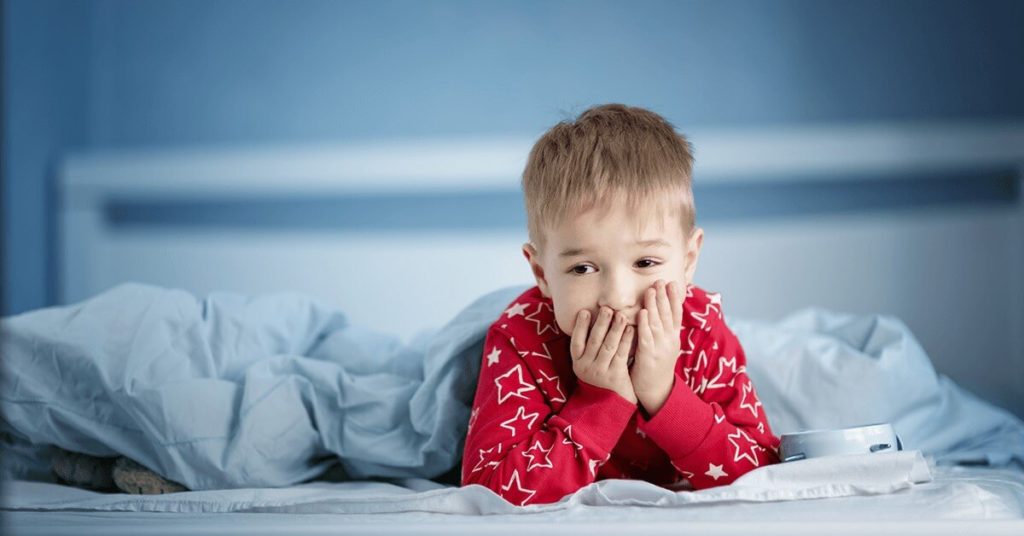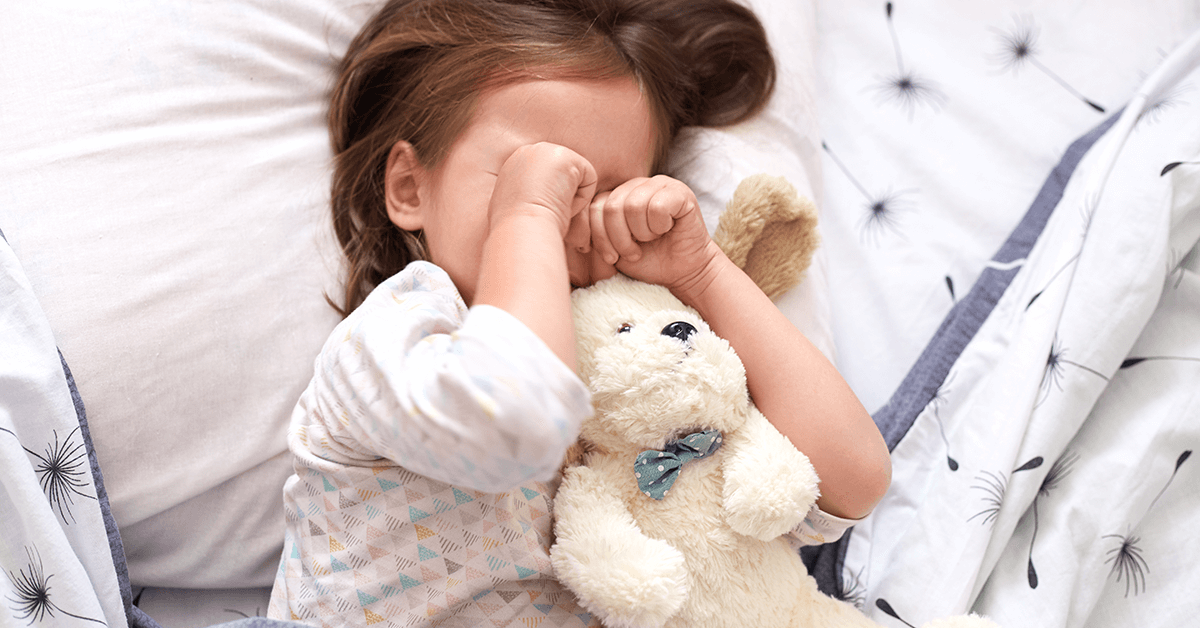
Medically reviewed by
Dacelin St Martin, MD
Triple board-certified in Sleep Medicine,
Internal Medicine, and Pediatrics.
Common Acute Conditions | Common Chronic Conditions | Special Considerations | Diagnosis | Management
Overview
Illnesses in children can be stressful, disrupting every portion of a child’s typical day. This disruption can cause a noticeable change in the ability of the child to get a restful sleep.
Sleeplessness in children can lead to poor daytime concentration, mood dysregulation, and behavioral problems.
Medical illnesses can cause pediatric insomnia, which can be defined as trouble going to sleep, staying asleep, or sleeping restfully.[1]
Usually, the medical conditions are common and acute, with treatment being the best method for improving the child’s sleep quality. However, chronic conditions can also result in pediatric insomnia and require more long-term treatment.
This article will highlight some common causes of pediatric insomnia due to medical illnesses and what you can do to help your child sleep through the night.
Common Acute Conditions
The cause of sleeplessness in children can be varied and multifaceted. Disorders that are conditioned, behavioral, or environmental, circadian rhythm-related, or diagnosed primary medical conditions can lead to insomnia. In this article, we will be focusing on medical illnesses in children.
When a child has new sleep issues while also battling a recent illness, the two are likely related. There are many common illnesses that can disrupt sleep and cause daytime sleepiness, including:
1) Otitis Media
Otitis media is commonly known as an earache and is the result of an infection occurring in the middle ear.
The infection pushes on a small membrane inside the ear, causing pain associated with other symptoms, such as fever, loss of appetite, and vomiting.[2] A physician can easily recognize an ear infection due to the inflammation at the tympanic membrane or eardrum.
An earache can make sleeping difficult for children recovering from the infection. The pain and fever can be distracting and make initiating sleep difficult. Sleep can also be disturbed during the night by leakage from the ear, known as effusion.
2) Allergic Rhinitis
Seasonal changes can cause children to temporarily suffer from sneezing, nasal congestion, and itchiness of the eyes and nose.
This allergic reaction to the changing seasons can be identified if it occurs only during certain times of the year, likely spring, and is absent the rest of the year.
Seasonal allergies are common in children, affecting up to 30 percent of children in the United States.
Insomnia is another common symptom of allergic rhinitis, with nasal congestion and itchiness making sleep difficult. Often, children who suffer from seasonal allergies also suffer from daytime sleepiness and excessive fatigue.[3]
3) Viral Infections
Viral infections include an umbrella of different illnesses, including the common cold and influenza.
Illnesses due to a virus are acute and can occur anytime. However, there is a much higher prevalence of viral infections during the fall and winter months.
Symptoms vary depending on the virus, but each virus usually has distinct traits. For example, the common cold often presents with nasal congestion, runny nose, and cough.[4] While the influenza virus more commonly presents with a fever combined with a cough.[5]
Viral infections can be disruptive to the regular sleep pattern of a child. Coughing can keep them from sleeping and can even wake a child up during the night. Fevers may also keep the child from comfortably sleeping and can lead to feelings of daytime sleepiness and fatigue.
4) Atopic Dermatitis
This condition is also known as eczema and is a common condition in children, with up to 20 percent of children worldwide suffering from it. Causes are often due to environmental allergens, which result in a breakout of skin lesions. The rash area during an eczema flare-up appears as a red, dry area that is extremely itchy.
A common symptom of eczema is the disturbance of sleep.[6] The severity of itchiness can make it difficult for children to fall asleep successfully. Additionally, treatments such as antihistamines and corticosteroids can influence sleep disturbances in a child.
Common Chronic Conditions
While sleep disturbances due to acute medical illnesses are common, there are common chronic illnesses that can disturb sleep. Many acute issues can become chronic if the illness persists for a long enough time.
- Chronic Otitis
- Chronic Allergic Rhinitis
- Chronic Eczema
- Chronic Cough
Other chronic conditions in children can also cause issues with sleep, including [7][8]
- Asthma
- Diabetes
- Enuresis
While these illnesses and conditions affect the body in different ways, they all share a detrimental effect on the sleep health of a child.
Significant Considerations
Other chronic conditions, including neurological and neurodevelopmental disorders, also commonly have sleep issues associated with them.
Problems with sleep-related to these diseases may come from the disease mechanism itself or associated behaviors. Some examples of these conditions are:
- Autism
- Epilepsy
- ADHD
- Cerebral Palsy
For each condition, it is difficult to identify the exact cause of an individual child’s sleeplessness.[9]
For example, a child with ADHD could have trouble sleeping due to excessive physical movement, or it could be a result of the medications used to treat ADHD.
When a child presents with a neurological condition and difficulty sleeping, the child must be examined to determine the root issue of sleeplessness.
Diagnosis
When diagnosing any illness, the first step is consulting with a physician. If your child is experiencing any condition, especially one resulting in sleep disturbance, treatment can alleviate the symptoms.
The physician will start by asking questions about the illness, followed by a physical examination. It’s essential during the history and examination to mention any noticeable sleep disturbance pattern to help the physician make the best treatment plan.
Management
Symptoms of sleeplessness that stem from a primary disorder should be resolved once the primary disorder is treated. For example, an inner ear infection resulting in sleep loss is best treated with an antibiotic. Although, this may only be true for certain acute conditions.
Sleep disturbances due to chronic conditions can provide a move challenging route for treatment. While treatment of the underlying condition is still the priority, additional sleep hygiene interventions may also be implemented.
Behavioral treatment may be necessary when a child suffers from sleep-wake cycle issues, bedtime anxiety, or behavioral issues affecting their sleep. Cognitive-behavioral therapy is effective in treating behavioral or conditioned causes of sleeplessness. The improvement of sleep hygiene often results in improved sleep and increased daytime functioning.
For children who do not respond to behavioral interventions, medication may be required. Iron therapy has shown to be effective in children who suffer from restless leg syndrome (RLS) and is often the first choice for medication treatment. However, if iron supplements prove ineffective, small doses of melatonin close to bedtime can show improvements in sleep onset and daytime functioning.
Conclusion
While various factors contribute to healthy sleep, both acute and chronic medical disorders can negatively affect sleep quality. Daytime sleepiness can directly impact a child’s mood, behavior, and cognitive function.
The medical disorder may be acute and go away without intervention; however, other more chronic conditions can leave a lasting negative impact on the child’s sleep quality.
Although treatment of medical disorder-related health issues is often the treatment of the medical issue itself, it is vital to pay attention to your child’s sleeping habits during the process of a medical disorder. If you have any concerns about your child’s sleep, it is essential to seek treatment from a physician.
References:
- Combs, D., Goodwin, J. L., Quan, S. F., Morgan, W. J., Shetty, S., & Parthasarathy, S. (2016, June 13). Insomnia, Health-Related Quality of Life and Health Outcomes in Children: A Seven Year Longitudinal Cohort. Nature News. https://www.nature.com/articles/srep27921.
- Hayden, G., & Schwartz, R. (1985, July 1). Characteristics of Earache Among Children With Acute Otitis Media. American Journal of Diseases of Children. https://jamanetwork.com/journals/jamapediatrics/fullarticle/512220.
- Koinis-Mitchell, D., Craig, T., Esteban, C. A., & Klein, R. B. (2012, August 3). Sleep and allergic disease: A summary of the literature and future directions for research. Journal of Allergy and Clinical Immunology. https://www.sciencedirect.com/science/article/abs/pii/S0091674912010305.
- Pappas, D., Hendley, J., Hayden, F., & Winther, B. (2008, January). Symptom profile of common colds in school-aged children. The Pediatric infectious disease journal. https://pubmed.ncbi.nlm.nih.gov/18162930/.
- Silvennoinen, H., Peltola, V., Lehtinen, P., Vainionpää, R., & Heikkinen, T. (2009, May). Clinical presentation of influenza in unselected children treated as outpatients. The Pediatric infectious disease journal. https://www.ncbi.nlm.nih.gov/pubmed/19295464.
- Smaldone, A., Honig, J. C., & Byrne, M. W. (2007, February 1). Sleepless in America: Inadequate Sleep and Relationships to Health and Well-being of Our Nation’s Children. American Academy of Pediatrics. https://pediatrics.aappublications.org/content/119/Supplement_1/S29.
- Weinstock, T. G., Rosen, C. L., Marcus, C. L., Garetz, S., Mitchell, R. B., Amin, R., … Redline, S. (2015, October 7). Predictors of obstructive sleep apnea severity in adenotonsillectomy candidates. Albert Einstein College of Medicine. https://einstein.pure.elsevier.com/en/publications/predictors-of-obstructive-sleep-apnea-severity-in-adenotonsillect-2.
- Raju, B., Arbelaez, A. M., Breckenridge, S. M., & Cryer, P. E. (2006, June 1). Nocturnal Hypoglycemia in Type 1 Diabetes: An Assessment of Preventive Bedtime Treatments. OUP Academic. https://academic.oup.com/jcem/article/91/6/2087/2843397.
- Grigg-Damberger, M., & Ralls, F. (n.d.). Treatment strategies for complex behavioral insomnia in… : Current Opinion in Pulmonary Medicine. https://journals.lww.com/co-pulmonarymedicine/Abstract/2013/11000/Treatment_strategies_for_complex_behavioral.6.asp


